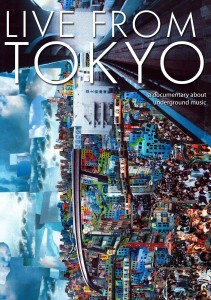JQ Magazine: DVD Review — ‘Live from Tokyo’ Explores Music’s Japanification

"What makes this film so unique is how the visuals compliment the subject matter. The music becomes more visceral when scenes from Tokyo’s fluorescent nightlife are flashing on the screen." (Good Charamel Records)
By Sam Frank, an ALT who taught English in Hiraizumi-Cho, Iwate-ken, from 2002-04 and worked in Shirahama-cho, Wakayama-ken as a JET from 2004-06, for JQ magazine. He currently manages the New York division of UnRated magazine and works as a project manager/Web producer at Arrow Root Media.
When it comes to cultural diversity, Japan has always been a borrower. Their entire writing system, known as kanji, is made up of Chinese characters; the country’s most popular sport is baseball, America’s pastime; and South Korean television dramas get all the top ratings. Japan’s music scene is no different. In Live from Tokyo, American director Lewis Rapkin takes us on a kaleidoscopic journey through Tokyo’s bustling underground music scene. Set within the backdrop of the modern Japanese megalopolis, the film explores Tokyo’s eccentric music culture, and how a combination of global information, media-saturated urban areas, and cutting edge innovation has impacted it.
“Since the 2000s, when the Internet became widely used, the number of people listening to underground music has been growing,” explains Murata, lead singer of the band Kuruucrew, during one of the film’s many fascinating interviews. There are many facets to Japan’s underground music scene, and Rapkin captures them beautifully. Early on in the film we learn how MP3s and digital downloads have altered Japan’s musical landscape. TokyoGigGuide.com’s Craig Eaton describes how you can now “get albums online, whereas in the past you’d have to wait until it came to your country or order it, and wait for it to come in the mail.” With a simple click, you can now access Japanese underground artists such as Shugo Tokumaru, Sexy-Synthesizer, and Sajjanu.
When we’re not learning about the underground scene through band interviews, Rapkin gives us an all-access pass to the bands as they perform on stage. Juxtaposed with time lapses of Shibuya’s nightlife, first person views from train lines, and kaitenzushi conveyor belts, we hear punk rock, J-pop, heavy metal, traditional Japanese music, and various synthesizer-based experiments.
For the complete story, click here.


Comments are closed.